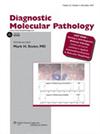Influence of parasite density and sample storage time on the reliability of Entamoeba histolytica-specific PCR from formalin-fixed and paraffin-embedded tissues.
引用次数: 20
Abstract
We report on the reliability of polymerase chain reaction (PCR) for the detection of Entamoeba histolytica from formalin-fixed, paraffin-embedded tissue in comparison with microscopy and have determined predictors that may influence PCR results. E. histolytica-specific and Entamoeba dispar-specific real-time PCR and microscopy from adjacent histologic sections were performed using a collection of formalin-fixed, paraffin-embedded tissue specimens obtained from patients with invasive amebiasis. Specimens had been collected during the previous 4 decades. Association of sample age, parasite density, and reliability of PCR was analyzed. E. histolytica PCR was positive in 20 of 34 biopsies (58.8%); 2 of these 20 were microscopically negative for amebae in neighboring tissue sections. PCR was negative in 9 samples with visible amebae in neighboring sections and in 5 samples without visible parasites in neighboring sections. PCR was negative in all specimens that were older than 3 decades. Low parasite counts and sample ages older than 20 years were predictors for false-negative PCR results. All samples were negative for E. dispar DNA. PCR is suitable for the detection of E. histolytica in formalin-fixed, paraffin-embedded tissue samples that are younger than 2 decades and that contain intermediate to high parasite numbers. Negative results in older samples were due to progressive degradation of DNA over time as indicated by control PCRs targeting the human 18S rRNA gene. Moreover, our findings support previous suggestions that only E. histolytica but not E. dispar is responsible for invasive amebiasis.寄生虫密度和样品保存时间对福尔马林固定和石蜡包埋组织中溶组织内阿米巴特异性PCR可靠性的影响。
我们报告了聚合酶链反应(PCR)检测溶组织内阿米巴的可靠性,从福尔马林固定,石蜡包埋的组织与显微镜比较,并确定了可能影响PCR结果的预测因素。利用从侵袭性阿米巴病患者获得的福尔马林固定、石蜡包埋的组织标本,对邻近组织学切片进行E.组织溶解特异性和内阿米巴差异特异性实时PCR和显微镜检测。在过去的40年里收集了标本。分析样本年龄、寄生虫密度与PCR可靠性的关系。34例活检中溶组织芽胞杆菌PCR阳性20例(58.8%);其中2例邻近组织切片镜检阿米巴阴性。9份邻近切片可见阿米巴虫,5份邻近切片未见寄生虫,PCR结果均为阴性。所有年龄大于30岁的标本PCR均为阴性。低寄生虫计数和样本年龄大于20岁是PCR假阴性结果的预测因子。所有样本均为阴性。PCR适用于用福尔马林固定、石蜡包埋、年龄小于20年且含有中高寄生虫数量的组织标本中溶组织芽孢杆菌的检测。在较老的样本中,阴性结果是由于DNA随着时间的推移而逐渐降解,正如针对人类18S rRNA基因的对照pcr所表明的那样。此外,我们的研究结果支持了先前的建议,即只有溶组织芽胞杆菌而不是异芽胞杆菌导致侵袭性阿米巴病。
本文章由计算机程序翻译,如有差异,请以英文原文为准。
求助全文
约1分钟内获得全文
求助全文
来源期刊
自引率
0.00%
发文量
0
审稿时长
>12 weeks
期刊介绍:
Diagnostic Molecular Pathology focuses on providing clinical and academic pathologists with coverage of the latest molecular technologies, timely reviews of established techniques, and papers on the applications of these methods to all aspects of surgical pathology and laboratory medicine. It publishes original, peer-reviewed contributions on molecular probes for diagnosis, such as tumor suppressor genes, oncogenes, the polymerase chain reaction (PCR), and in situ hybridization. Articles demonstrate how these highly sensitive techniques can be applied for more accurate diagnosis.

 求助内容:
求助内容: 应助结果提醒方式:
应助结果提醒方式:


